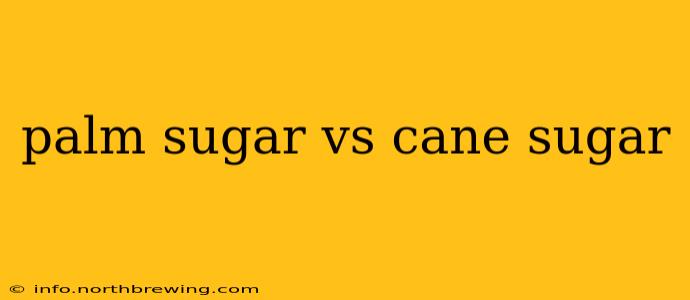Choosing between palm sugar and cane sugar often comes down to personal preference, but understanding their differences can significantly impact your culinary choices and health considerations. Both are natural sweeteners, but their origins, flavor profiles, and nutritional compositions vary considerably. This comprehensive guide delves into the nuances of each, helping you make an informed decision.
What is Palm Sugar?
Palm sugar, also known as jaggery, is derived from the sap of various palm trees, primarily the Asian Palmyra palm and the date palm. The sap is collected, boiled down, and then solidified into blocks or crystals. Its production is often less processed than cane sugar, contributing to a richer flavor profile and a slightly more complex nutritional makeup.
What is Cane Sugar?
Cane sugar, the more common sweetener globally, is extracted from sugarcane stalks. The stalks are crushed, and the juice is processed through a series of steps to refine and crystallize the sucrose. This refining process often removes many of the naturally occurring minerals and vitamins found in the original sugarcane juice. The result is a pure, white, granular sugar.
Palm Sugar vs. Cane Sugar: A Nutritional Comparison
While both are sources of carbohydrates and calories, their nutritional profiles differ significantly. Palm sugar often contains trace amounts of minerals like iron, potassium, and zinc, while refined cane sugar generally lacks these nutrients. This difference is largely due to the processing methods. However, it's important to note that the nutritional content can vary depending on the specific type of palm sugar and the processing techniques used. Neither should be consumed in excess.
H2: Is Palm Sugar Healthier Than Cane Sugar?
This is a complex question without a simple yes or no answer. While palm sugar retains more of its natural minerals, both are high in calories and added sugars. The glycemic index (GI) of palm sugar is generally lower than that of white cane sugar, meaning it may cause a slower rise in blood sugar levels. However, this difference isn't drastic enough to solely define one as definitively "healthier." Moderation in consumption is key for both.
H2: What Does Palm Sugar Taste Like?
Palm sugar possesses a distinctive caramel-like flavor with subtle notes of molasses and brown sugar. Its flavor intensity can vary depending on the type of palm and the processing method. It often imparts a richer, more complex sweetness to dishes compared to the cleaner taste of cane sugar.
H2: What Does Cane Sugar Taste Like?
Cane sugar, especially in its refined white form, offers a clean, sweet taste without pronounced undertones. This neutral flavor makes it versatile in baking and cooking, allowing it to complement other ingredients without overwhelming the palate. Brown sugar, a less refined form of cane sugar, retains some molasses, giving it a slightly deeper flavor than white sugar.
H2: Which is Better for Baking?
The choice between palm and cane sugar for baking depends on the desired outcome. Cane sugar, particularly granulated white sugar, is preferred for recipes requiring precise crystallization and specific texture, such as meringues or certain types of cakes. Palm sugar, due to its moisture content and complex flavor, can be used as a partial replacement for cane sugar, adding depth and richness to baked goods, but may affect texture and rising. Experimentation is key to finding the right balance.
H2: Which is Better for Cooking?
For cooking, both can be used, but their flavor profiles influence the final dish. Palm sugar's caramel-like notes complement savory dishes like stir-fries or curries, adding a unique sweetness and depth. Cane sugar is a suitable sweetener for many cooking applications where a neutral, clean sweetness is desired.
H2: What are the Different Types of Palm Sugar?
Palm sugar comes in various forms, including solid blocks, granulated crystals, and liquid forms. The form impacts how it's used in recipes. Blocks require grating or dissolving, while crystals and liquid forms are more convenient for direct addition.
H2: Where can I buy palm sugar?
Palm sugar is increasingly available in health food stores, Asian markets, and online retailers. Its accessibility varies depending on geographic location.
In conclusion, the "better" sweetener depends entirely on your individual needs and preferences. While palm sugar may offer a slightly more complex nutritional profile and richer flavor, neither surpasses the other in terms of overall health benefits when consumed excessively. Understanding their unique characteristics empowers you to make conscious choices aligned with your dietary goals and culinary aspirations.
